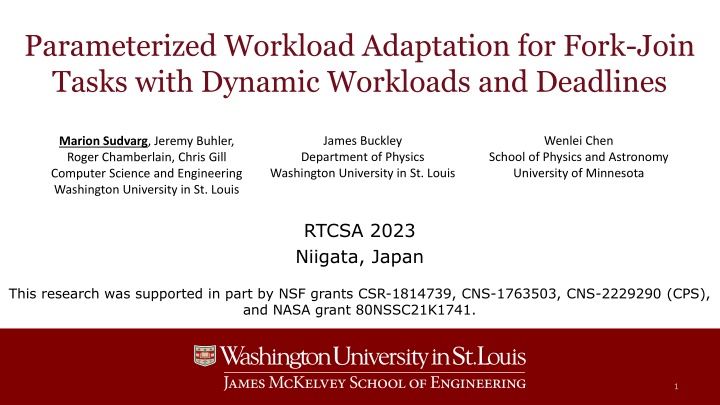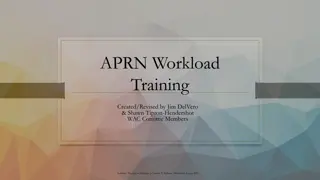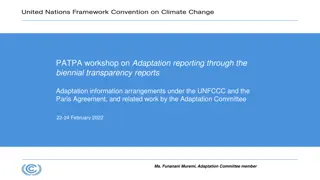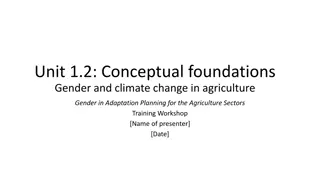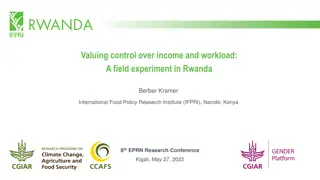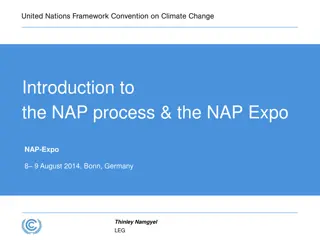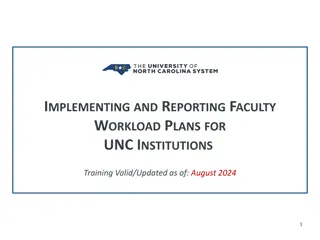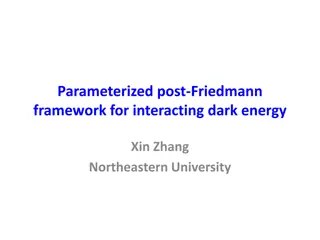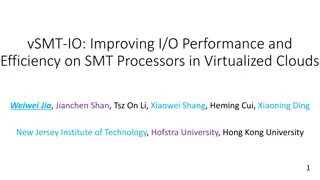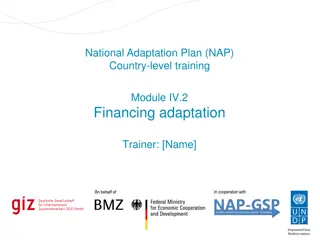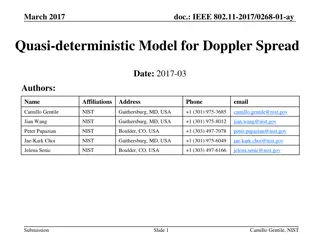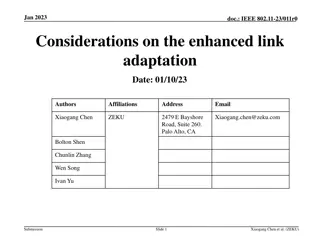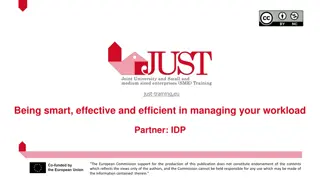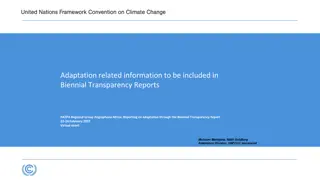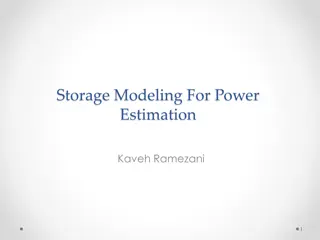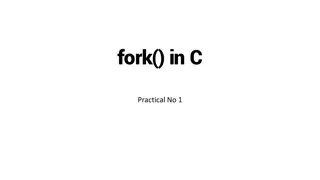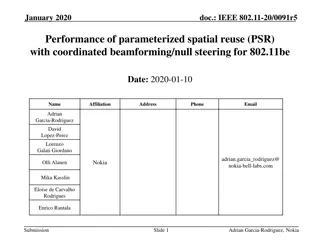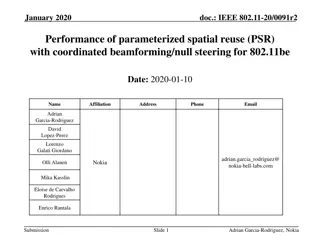Parameterized Workload Adaptation for Fork-Join Tasks with Dynamic Workloads and Deadlines
In dynamic environments, tasks may face unknown workloads and deadlines, leading to system overload and missed deadlines. This research focuses on adapting task workloads to provide results before the deadline by adjusting computational parameters. It explores how to minimize degradation of result utility while meeting dynamic constraints of schedulability, utilizing multiple degrees of freedom in workload adaptation. Motivated by the Advanced Particle-astrophysics Telescope project, the study aims to optimize computational workload adjustments for real-time applications like Gamma-Ray Burst localization.
Download Presentation

Please find below an Image/Link to download the presentation.
The content on the website is provided AS IS for your information and personal use only. It may not be sold, licensed, or shared on other websites without obtaining consent from the author.If you encounter any issues during the download, it is possible that the publisher has removed the file from their server.
You are allowed to download the files provided on this website for personal or commercial use, subject to the condition that they are used lawfully. All files are the property of their respective owners.
The content on the website is provided AS IS for your information and personal use only. It may not be sold, licensed, or shared on other websites without obtaining consent from the author.
E N D
Presentation Transcript
Parameterized Workload Adaptation for Fork-Join Tasks with Dynamic Workloads and Deadlines James Buckley Department of Physics Washington University in St. Louis Wenlei Chen Marion Sudvarg, Jeremy Buhler, Roger Chamberlain, Chris Gill Computer Science and Engineering Washington University in St. Louis School of Physics and Astronomy University of Minnesota RTCSA 2023 Niigata, Japan This research was supported in part by NSF grants CSR-1814739, CNS-1763503, CNS-2229290 (CPS), and NASA grant 80NSSC21K1741. 1
In dynamic environments, task workloads and deadlines may not be known prior to job release May result in system overload jobs unable to meet deadlines Adjust computational parameters to provide an imprecise result prior to the deadline Anytime workloads Select from a discrete set of computational modes RTCSA 2023 Marion Sudvarg 2
But these semantics may not fully capture the dimensions over which a task s workload can adapt to meet its deadline Computations may have multiple parameterized degrees of freedom (categorical, discrete numeric, continuous numeric) Given an allocation of resources to a task How do we adjust its computational workload to minimize degradation of result utility While remaining within the dynamic constraints of schedulability? RTCSA 2023 Marion Sudvarg 3
How do we adapt to minimize loss within schedulability constraints? 1. Identify parameterized degrees of freedom over which computational workload may be compressed 2. Characterize loss over parameter space 3. Characterize worst-case response times 4. Reduce parameter space to Pareto- optimal surface 5. Online: search for best set of parameters satisfying constraints RTCSA 2023 Marion Sudvarg 4
Motivating Example The Advanced Particle-astrophysics Telescope (APT) RTCSA 2023 Marion Sudvarg 5
Real-Time Gamma-Ray Burst (GRB) Localization GRBs are rapid, immense bursts of energy We are developing a satellite telescope to detect and localize GRBs in real-time Will enable secondary instruments to immediately point at the burst Algorithms will run on embedded hardware onboard the satellite Image courtesy NASA, ESA and M. Kornmesser (https://www.nasa.gov/feature/goddard/2019/hubble-studies-gamma-ray-burst-with-highest-energy-ever-seen) RTCSA 2023 Marion Sudvarg 6
Challenge: Dynamic Workloads and Deadlines Every GRB is unique! Workload depends on Deadline may depend on Brightness The number of gamma rays entering the detector The duration of the burst (103 106 incident gamma rays) Spectral energy distributions Availability of follow-up instruments Their physical interactions with the detector Initial burst durations (10 milliseconds 20 minutes) Not known prior to burst arrival! How can we adapt and compress the computational pipeline to maximize localization accuracy even for bright transients while guaranteeing short deadlines? RTCSA 2023 Marion Sudvarg 7
Adapt to Minimize Loss within Schedulability Constraints 1. Identify parameterized degrees of freedom over which computational workload may be compressed Event Source Iterative Refinement Reconstruction Approximation Sample Size Number of gamma- rays selected for reconstruction Number of Iterations Technique RTCSA 2023 Marion Sudvarg 8
Adapt to Minimize Loss within Schedulability Constraints 2. Characterize loss (due to compression) over parameter space Expected 68% confidence in GRB localization error RTCSA 2023 Marion Sudvarg 9
Adapt to Minimize Loss within Schedulability Constraints 3. Characterize worst- case response times (WCRT) Linear In Quadratic In Multiplied By Linear In With constants defined by Highly Parallelizable Fork-Join Number of Iterations Sample Size Number of gamma- rays selected for reconstruction Technique RTCSA 2023 Marion Sudvarg 10
Adapt to Minimize Loss within Schedulability Constraints 4. Reduce parameter space to Pareto-optimal subset Sort parameter space by WCRT Reduce to subset of candidate parameter space where loss decreases as WCRT increases 2657 ~80 initial candidate parameter sets parameter sets in Pareto-optimal subset RTCSA 2023 Marion Sudvarg 11
Adapt to Minimize Loss within Schedulability Constraints 5. Online: search for best set of parameters satisfying the dynamic constraints Binary search over Pareto-optimal parameter subspace to find best parameter set with WCRT not exceeding deadline Interpolate or extrapolate over parameter + WCRT surface to find Pareto-optimal parameters with WCRT equal to deadline RTCSA 2023 Marion Sudvarg 12
Results and Conclusions Imposed 33ms deadline: Localized to within 1 degree! Worst-case response time on flight computer: 200ms 1.3s Simulated 4 known short, bright GRBs Offline parameter and loss characterization allows for fast online workload adaptation for GRB localization! This approach extends to other dynamic fork-join workloads with loss functions that are difficult to characterize in closed form. Slack reclamation and OpenMP implementation tricks discussed in paper. RTCSA 2023 Marion Sudvarg 13
Thank You! Any Questions? RTCSA 2023 Marion Sudvarg 14
Methods for Utilization Compression 1. Increase task period: U=C/T Straightforward when D=T (implicit-deadline) What if D is fixed (constrained-deadline)? 2. Decrease task workload How can we adapt task computation while minimizing the impact on result quality? Pareto-Optimization RTCSA 2023 Marion Sudvarg 15
2. Characterize Loss over Parameter Space APT: expected 68% confidence in GRB localization error Loss may not be easily fit to closed-form function of compressible parameters Use union of half spaces, constrained by parameter bounds RTCSA 2023 Marion Sudvarg 16
Localization Accuracy By Events Reconstructed RTCSA 2023 Marion Sudvarg 17
Approximation Accuracy vs Computation RTCSA 2023 Marion Sudvarg 18
3. Characterize Worst-Case Response Times Determine subtask WCETs as function of input parameters Use these to upper-bound task response time given allocated cores at each tested point in parameter space We can be less pessimistic! RTCSA 2023 Marion Sudvarg 19
Event Reconstruction Response Times RTCSA 2023 Marion Sudvarg 20
Approximation Response Times ApproxCircles FibSpiral RTCSA 2023 Marion Sudvarg 21
Refinement Response Times RTCSA 2023 Marion Sudvarg 22
Improved Processor Assignment If C, L, and D all integers, Heuristics based on DAG structure (critical path and workload rooted from each node) often optimal Express processor assignment as subgraph isomorphism, often feasible to solve with Glasgow Subgraph Solver Dual Find minimum core assignment for given deadline Upper bound response time for given core assignment M. Sudvarg and C. Gill. Analysis of Federated Scheduling for Integer-Valued Workloads. RTNS 2022. RTCSA 2023 Marion Sudvarg 23
4. Online Pareto-Optimal Compression Sort parameter space by response time Produce Pareto-optimal candidate set loss monotonically decreasing as function of response time APT: reduces state space cardinality from 2657 to ~80 Given a dynamic workload and deadline online, find minimum candidate state under constraints Linear or quasilinear on size of reduced state space APT: <250 s on RPi3 Apply parameters to computation before execution begins RTCSA 2023 Marion Sudvarg 24
Slack Reclamation Iterative Refinement Approx Source Compress Reconstruct Produce Result Slack? No Yes Refinement Iteration Reconstruct RTCSA 2023 Marion Sudvarg 25
Overheads RTCSA 2023 Marion Sudvarg 26
Comparisons of Interpolation, Extrapolation, and Slack Reclamation RTCSA 2023 Marion Sudvarg 27
APT Compressed Localization Results: RPi3 RTCSA 2023 Marion Sudvarg 28
APT Compressed Localization Results: RPi4 RTCSA 2023 Marion Sudvarg 29
APT Compressed Localization Results: Atom RTCSA 2023 Marion Sudvarg 30
Results and Conclusions Imposed 33ms deadline: Localized to within 1 degree! Worst-case response time on flight computer: 200ms 1.3s Simulated 4 known short, bright GRBs Offline parameter and loss characterization allows for fast online workload adaptation for GRB localization! This approach extends to other dynamic fork-join workloads with loss functions that are difficult to characterize in closed form Other tricks discussed in paper, e.g., reducing pessimism through slack reclamation Future work: federated scheduling of general DAG tasks. Response times can be characterized given core allocation, but interpolation/extrapolation may be difficult. What if core allocations are not fixed a priori? RTCSA 2023 Marion Sudvarg 31
